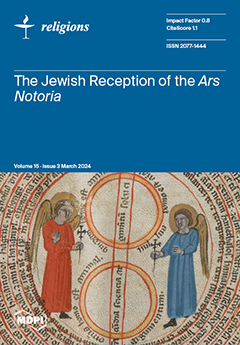Interreligious engagement (IE) has been experienced and theorized mainly as the pursuit of a shared respectful awareness of the beliefs, practices, and social experiences of multiple religious communities. In rare instances, it has been possible to create architecture specifically to foster IE, as
[...] Read more.
Interreligious engagement (IE) has been experienced and theorized mainly as the pursuit of a shared respectful awareness of the beliefs, practices, and social experiences of multiple religious communities. In rare instances, it has been possible to create architecture specifically to foster IE, as in the “tri-faith” Abrahamic campus in Omaha and the Berlin House of One. The theme is: Here
we are, accepting that we share the world. Another form of IE that deserves to attract more interest is multireligious collaboration in civic work (addressing homelessness, urban blight, illiteracy, etc.). Some adherents of the intrinsically cosmopolitan “world” religions are actively cosmopolitan to the extent of seeking this engagement. The theme is: Let us share the work of the world, including sharing our religiously inflected processing of what the practical issues facing us are. There is a new initiative of this sort in my city, Jackson, Mississippi, named (from M. L. King) the “Beloved Community”. An architectural thought experiment may prove helpful in articulating the ideals for such an endeavor. What would be the physical desiderata for its headquarters? Let us imagine a new downtown building, The Meeting, dedicated to housing meetings where mixed religious groups learn about civic issues and coordinate efforts to address them. Full interreligious sharing of a space seems to require a neutral design lacking any definite religious inspiration. But there are nonsectarian ways to create an appreciably
special, non-ordinary space, as in courtrooms and classrooms. Could a civic IE headquarters be special, expressive of practical optimism, and contain a sufficient religious allusion to qualify as a “next-to-sacred space” in which religious actors felt supported in the civic extension of their religious lives? I offer suggestions for discussion, including (1) a pavilion-style building suggestive of being set up for a special purpose—not soaringly grandiose but with a vertical feature such as a central roof lantern; (2) at least one major porch, with benches and tables; (3) an outside water fountain with public water supply (a historical allusion to the Islamic
sabil); (4) inside, right-sized meeting rooms around the glass-walled periphery; (5) a big “living room” lounge in the center, usable for larger meetings, with access to a kitchen, and with a big project board for tracking work completed and work in hand next to a large map of the city; (6) a moderate descent of several steps into each meeting room so that there is a feeling of commitment in attending a meeting and a sense of challenge in going forth from one; (7) otherwise a main floor levelness and openness facilitating movement in and out, as in a train station; and (8) upstairs small offices for religious and other qualifying organizations. Answering the aesthetic and practical questions these suggestions raise takes us into imagining civic IE more concretely.
Full article





